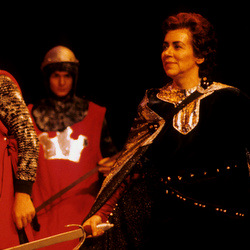Bellini alla Malibran
by Hilary Poriss
In the autumn of 1832, when Maria Malibran (1808–36) was at the height of her fame—recognized widely as one of the most accomplished and exciting prima donnas touring the international operatic circuit—she arrived at Bologna’s Teatro Comunale where she took on the trousers role of Romeo in Bellini’s I Capuleti e i Montecchi (Venice, 1830) for the first time. No different from other celebrated singers of her era, Malibran was accustomed to approaching unfamiliar scores with a sense of freedom, making use of aria insertions when necessary. What she and her co-star Giuliettas did with the final scene of I Capuleti e i Montecchi, the “tomb scene,” however, was extraordinary: they eliminated all of Bellini’s music and replaced it with the corresponding scene from the older, but still popular, Giulietta e Romeo by Nicola Vaccai (Milan, 1825).
Like many other substitutions that occurred within the bel canto repertory, this one did not disappear when the final curtain of the season was drawn. Following the Bologna production, Malibran played Romeo on at least five other occasions, each time trading in Bellini’s music for Vaccai’s. What is more, beginning as early as 1833 other divas began to follow her lead, performing the opera “alla Malibran.” Librettos reveal that nearly two thirds of all productions between 1833 and 1857 featured the Vaccai ending. The practice of replacing Bellini’s music with Vaccai’s had become so common, in fact, that a piano-vocal score published by Ricordi includes Vaccai’s scene in an appendix. A note prefacing it reads: “To be substituted, if desired, as is generally done, for the last scene of Bellini’s opera.”
A resounding testament to the fascination that this version continues to exert is the recent publication of two new scholarly explorations of the topic: the first, an expansive article by Michael Collins sketching out the production history of I Capuleti e i Montecchi; the second, by Claudio Toscani, a detailed exploration of the reception of the tomb-scene alteration throughout European centers during the nineteenth century. (Toscani’s essay was written in conjunction with his work as editor of the critical edition of I Capuleti e i Montecchi.)* Collins and Toscani introduce a pair of important, and overlapping, details: the startling discovery, for one thing, that Maria Malibran was not, in fact, the first singer in the role of Romeo to perform Vaccai’s tomb scene in place of Bellini’s. Whether or not Malibran was the first to change the tomb scene, however, that version was soon widely known as the “pasticcio alla Malibran.” It was she who generated the fashion.
 |
|
| Stephanie Friedman as Romeo in I Capuleti e i Montecchi |
For another: substituting the Vaccai ending was not the only alteration that Malibran and her Giuliettas made.On the occasion of herinitial appearance as Romeo in Bologna, she and Sofia Schoberlechner eliminated the Act I scena e duetto, “Sì, fuggire: a noi non resta,” in favor of a new duet: “Tremante, palpitante,” composed by Filippo Celli for his little known and little performed opera Ezio(Rome, 1824). This was well received: the critic for Teatri arti e letteratura commented that “the duet by Cavalier Cellifrom Ezio, which possesses many good qualities, above all in the Largo, was performed with the most exquisite perfection that it would be absolutely impossible to surpass it, and even one might say, to equal it.” Yet there is no evidence that any Romeo-and-Giulietta sang it in Bellini’s opera ever again.
By contrast, for every production in which Malibran participated, she and her co-star (either Schoberlechner or Giuseppina Ruiz-Garcia) interpolated Mercadante’s “Vanne: se alberghi in petto” from Andronico(Venice, 1821)—this time replacing none of Bellini’s music. Mercadante’s duet had a long-lasting impact on the performance history of I Capuleti e i Montecchi that—like the tomb-scene alteration—was also tied to Malibran’s unique biographical story, or rather, to one of its most interesting facets: her premature death following a violent horse riding accident in 1836 at the tragically young age of twenty-eight.
—Adapted from “Maria Malibran, I Capuleti e i Montecchi, and a Tale of Suicide,” ch. 4 of Changing the Score: Arias, Prima Donnas, and the Authority of Performance, AMS Studies in Music (Oxford UP, 2009).
*See Michael Collins, “Bellini and the Pasticcio alla Malibran: A Performance History of I Capuleti e i Montecchi,” Note su note 9–10 (2002): 109–52; and Claudio Toscani, “Bellini e Vaccaj: peripezie di un finale,” in Vincenzo Bellini nel secondo centenario della nascita, ed. Graziella Seminara and Anna Tedesco (Florence: Leo S. Olschki, 2004), 535-67; also Toscani’s edition: Vincenzo Bellini, I Capuleti e i Montecchi, ed. Claudio Toscani, in Edizione critica delle opere di Vincenzo Bellini, vol. 6 (Milan: Ricordi, 2003), xi–xxix. In addition, Philip Gossett discusses this alteration and its aftermath in Divas and Scholars(University of Chicago Press, 2006), 211–12.
Hilary Poriss is Associate Professor of Music at Northeastern University in Boston. She is editor, with Roberta Montemorra Marvin, of Fashions and Legacies of Nineteenth-Century Italian Opera (Cambridge UP, 2009); and, with Rachel Cowgill, The Arts of the Prima Donna in the Long Nineteenth Century (Oxford UP, 2012).


